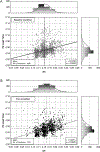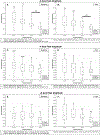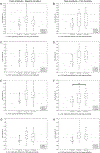Mouse incising central pattern generator: Characteristics and modulation by pain
- PMID: 30149084
- PMCID: PMC6195457
- DOI: 10.1016/j.physbeh.2018.08.012
Mouse incising central pattern generator: Characteristics and modulation by pain
Abstract
Introduction: Vertebrate incising and chewing are controlled by a set of neurons comprising the central pattern generator (CPG) for mastication. Mandibular positioning and force generation to perform these tasks is complex and requires coordination of multiple jaw opening and closing muscle compartments located in muscles on both sides of the jaw. The purpose of this study was to determine the characteristics of the CPG by recording mouse incising forces in the home cage environment to evaluate changes in force characteristics with incising frequency and force direction. A second purpose was to evaluate the effects of jaw closing muscle pain on CPG output parameters.
Methods: Digitized incising forces were recorded for approximately 24 h using a 3-dimensional force transducer attached to solid food chow. Male and female CD-1 mice were evaluated during their last (fourth) baseline assessment and seven days after a second acidic saline injection into the left masseter muscle when maximum pain was experienced. Incising force resultants were calculated from the three axes data and force parameters were assessed including inter-peak intervals (IPI), peak amplitude, load time and unload time. Multiple regression analyses were conducted to identify incising episodes that had parameters of force that were significantly correlated (p < 0.001). These incising episodes were considered to represent the output of the CPG with a steady state of incoming sensory afferent inputs. Incising parameters were evaluated for each of the discrete incising frequencies (4.6, 5.3, 6.2, 7.6 Hz) and the predominant force directions: jaw closing (-Z), jaw retrusion (+X) and jaw protrusion (-X).
Results: A significant correlation between incising frequency (IPI) and the load time was observed. A significant decrease in peak amplitude was observed with higher incising frequency while the load rate significantly increased. The force peak amplitude and load rates were found to be statistically different when the force direction was considered, with smaller peak amplitudes and smaller load rates found in the jaw closing direction. The effect of pain on incising was to reduce the peak amplitude and load rate of incising compared to the baseline condition at lower incising frequencies.
Conclusions: Like the central pattern generator for locomotion, the CPG for incising controls rhythmicity, peak amplitude and force load duration/rate. However, unlike the CPG for locomotion, the amplitude of incising force decreases as the frequency increases. During incising, load rate increases with faster rhythm and is consistent with the recruitment of larger motor units. Muscle pain reduced the excitatory drive of the CPG on motoneurons and provides further support of the Pain Adaptation Model.
Keywords: Animal behavior; Central pattern generator; Hyperalgesia; Masticatory muscle; Physiological adaptation.
Copyright © 2018 Elsevier Inc. All rights reserved.
Conflict of interest statement
Conflict of Interest
The authors have no known conflicts of interest associated with this publication and received no significant financial support for this work that could have influenced the outcome of the study.
Figures














Similar articles
-
Mouse preferential incising force orientation changes during jaw closing muscle hyperalgesia and is sex dependent.Physiol Behav. 2016 Dec 1;167:132-144. doi: 10.1016/j.physbeh.2016.09.005. Epub 2016 Sep 9. Physiol Behav. 2016. PMID: 27619173 Free PMC article.
-
Assessment of incising ethology in the absence and presence of jaw muscle hyperalgesia in a mouse home cage environment.Physiol Behav. 2015 Oct 1;149:229-38. doi: 10.1016/j.physbeh.2015.06.015. Epub 2015 Jun 12. Physiol Behav. 2015. PMID: 26074204 Free PMC article.
-
Electromyography and bite force studies of muscular function and dysfunction in masticatory muscles.Swed Dent J Suppl. 1986;37:1-64. Swed Dent J Suppl. 1986. PMID: 3465056 Clinical Trial.
-
Symphyseal fusion and jaw-adductor muscle force: an EMG study.Am J Phys Anthropol. 2000 Aug;112(4):469-92. doi: 10.1002/1096-8644(200008)112:4<469::AID-AJPA5>3.0.CO;2-V. Am J Phys Anthropol. 2000. PMID: 10918125 Review.
-
Generation of masticatory rhythm in the brainstem.Neurosci Res. 1995 Aug;23(1):1-19. Neurosci Res. 1995. PMID: 7501294 Review.
Cited by
-
Roles for cerebellum and subsumption architecture in central pattern generation.J Comp Physiol A Neuroethol Sens Neural Behav Physiol. 2024 Mar;210(2):315-324. doi: 10.1007/s00359-023-01634-w. Epub 2023 May 2. J Comp Physiol A Neuroethol Sens Neural Behav Physiol. 2024. PMID: 37130955 Free PMC article. Review.
-
Voluntary biting behavior as a functional measure of orofacial pain in mice.Physiol Behav. 2019 May 15;204:129-139. doi: 10.1016/j.physbeh.2019.02.024. Epub 2019 Feb 21. Physiol Behav. 2019. PMID: 30797813 Free PMC article.
References
-
- Hylander WL Incisal bite force direction in humans and the functional significance of mammalian mandibular translation. Am J Phys Anthropol 1978,48:1–7. - PubMed
-
- Hiiemae K, Heath MR, Heath G, Kazazoglu E, Murray J, Sapper D, et al. Natural bites, food consistency and feeding behaviour in man. Arch Oral Biol 1996,41:175–89. - PubMed
-
- Morquette P, Lavoie R, Fhima MD, Lamoureux X, Verdier D, Kolta A Generation of the masticatory central pattern and its modulation by sensory feedback. Prog Neurobiol 2012,96:340–55. - PubMed
Publication types
MeSH terms
Grants and funding
LinkOut - more resources
Full Text Sources
Other Literature Sources

